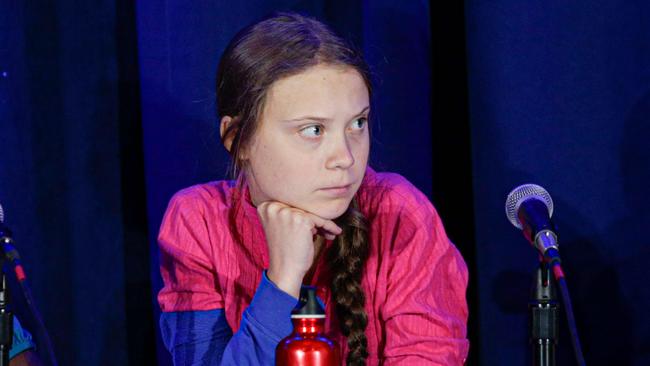Greta Thunberg: more threat than detail on climate action
Climate campaigner Greta Thunberg’s performance before the UN needs to be challenged.

When child climate campaigner Greta Thunberg told world leaders in New York on Tuesday (AEST) that global youth was watching, she probably did not expect them to laugh. But the response to her opening remarks was awkward laughter, followed by polite cheers and applause.
At 16, Thunberg has risen from a young girl too sick to attend school because of stress to become a global brand for those pushing for maximum action on climate change.
For many, her emotional performance before the UN this week provides a window into how badly things might go wrong.
MORE: Greta Thunberg responds to Donald Trump’s mocking of her online | Chris Kenny — End this sideshow for her sake
Thunberg’s pronouncements have been accepted largely without challenge.
However, her speech to the UN climate summit was heavy on rhetoric and threats but short on detail and facts.
THUNBERG SPEECH
My message is that we’ll be watching you.
(Thunberg claims to be speaking on behalf of a well-organised movement that has shown itself to be capable of mobilising millions of people to protest.)
This is all wrong. I shouldn’t be up here. I should be back in school on the other side of the ocean. Yet you all come to us young people for hope. How dare you!
(Thunberg blames world leaders for her decision to stage a school strike and protest in New York.)
You have stolen my dreams and my childhood with your empty words. And yet I’m one of the lucky ones. People are suffering. People are dying. Entire ecosystems are collapsing. We are in the beginning of a mass extinction, and all you can talk about is money and fairytales of eternal economic growth. How dare you!
(Thunberg paints a picture of ecocatastrophe and sides with developing nations that blame the developed world for not providing billions in financial support.)
For more than 30 years, the science has been crystal clear. How dare you continue to look away and come here saying that you’re doing enough, when the politics and solutions needed are still nowhere in sight.
(Thunberg overstates Intergovernmental Panel on Climate Change findings, which have evolved during the past three decades and continue to present wide bands of possible outcomes.)
You say you hear us and that you understand the urgency. But no matter how sad and angry I am, I do not want to believe that. Because if you really understood the situation and still kept on failing to act, then you would be evil. And that I refuse to believe.
(Thunberg says she still has faith that leaders will act.)
The popular idea of cutting our emissions in half in 10 years only gives us a 50 per cent chance of staying below 1.5 degrees (of warming) and the risk of setting off irreversible chain reactions beyond human control.
(UN Secretary-General Antonio Guterres asked world leaders to increase their ambition at the New York conference to reduce carbon dioxide emissions by 50 per cent by 2030.)
Fifty per cent may be acceptable to you. But those numbers do not include tipping points, most feedback loops, additional warming hidden by toxic air pollution or the aspects of equity and climate justice. They also rely on my generation sucking hundreds of billions of tonnes of your carbon dioxide out of the air with technologies that barely exist.
(Thunberg is referring to so-called tipping points that are still poorly understood. Concerns include: the impact of changes in ocean circulation on regional weather patterns, accelerating ice melt leading to sea level rise, and the rapid release of methane from thawing permafrost. The latest research in Nature is that methane release from permafrost and hydrates will happen as a gradual chronic leak acting as a modest feedback on warming, rather than being a sudden, catastrophic release. Research suggests a summer ice-free Arctic would worsen regional warming and impacts but would not cause a big or sudden increase in global temperatures.)
So a 50 per cent risk is simply not acceptable to us — we who have to live with the consequences. To have a 67 per cent chance of staying below a 1.5 degrees global temperature rise — the best odds given by the (IPCC) — the world had 420 gigatonnes of carbon dioxide left to emit back on January 1, 2018. Today that figure is already down to less than 350 gigatonnes.
(According to the IPCC special report on 1.5C warming, CO2 emissions will need to decline by about 45 per cent from 2010 levels by 2030, reaching net zero in about 2050 to meet the 1.5C target. For limiting global warming to below 2C with at least 66 per cent probability CO2 emissions are projected to decline by about 25 per cent by 2030 in most pathways and reach net zero in about 2070.)
How dare you pretend that this can be solved with just “business as usual” and some technical solutions? With today’s emissions levels, that remaining carbon dioxide budget will be entirely gone within less than 8.5 years.
(The carbon budget quoted by Thunberg is a simplified way to measure the additional emissions that can enter the atmosphere to stay below 1.5C, or any other temperature limit. It is seen as a key number for policymakers but it is extremely complex and has consistently been revised upwards. The level of climate sensitivity — the change in global mean near-surface air temperature that would result from a doubling of the atmospheric CO2 concentration — is a crucial part of the calculation for a carbon budget. The climate sensitivity assumed in climate models has been refined across time, which has updated the carbon budgets. The IPCC Fifth Annual Report broadened the range of likely climate sensitivity to between 1.5C to 4.5C.)
There will not be any solutions or plans presented in line with these figures here today because these numbers are too uncomfortable. And you are still not mature enough to tell it like it is.
(Thunberg rejects the efforts of leaders at the UN conference in advance.)
You are failing us. But the young people are starting to understand your betrayal. The eyes of all future generations are upon you. And if you choose to fail us, I say: We will never forgive you. We will not let you get away with this. Right here, right now is where we draw the line. The world is waking up. And change is coming, whether you like it or not.
(Thunberg makes a veiled threat that protests will increase, with reprisals for current world leaders).
Thank you.




To join the conversation, please log in. Don't have an account? Register
Join the conversation, you are commenting as Logout